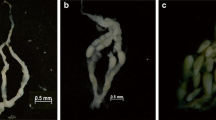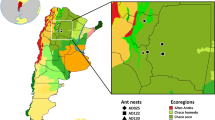Summary
As in the red wood antFormica polyctena (Otto, 1958) the ovariole development inFormica sanguinea workers consists of eight stages well defined in time. This is revealed by investigations on workers of well known age. The undifferentiated tubes in young workers develop more and more into protuberant chambers, reaching a maximum growth around the fourth week. They then regress rather rapidly and after five weeks most ovarioles look like empty tubes containing some yellow bodies. Ovarioles of workers older than one year and a half, however, can be in various stages according to their physiological condition in the nest: foraging workers always have fully degenerated ovarioles, while the hibernating individuals still can have ovarioles in an early regression stage. The number of ovarioles seems to be related to body length: small individuals have on the average two ovarioles on each side, larger ones three to five.
Resume
Dans le développement des ovarioles des ouvrières deFormica sanguinea, on peut distinguer huit phases qui correspondent à celles de la fourmi rousseFormica polyctena (Otto, 1958). Ces phases constituent un cycle bien défini chez des ouvrières dont l'âge est connu précisément: les tubes indifférenciés des jeunes individus montrent un nombre croissant de chambres gonflées, le maximum étant atteint vers la quatrième semaine. Une dégénération assez rapide se manifeste peu après, de sorte que la plupart des ovarioles apparaissent comme des tubes vides contenant encore quelques corps jaunes. Chez les ouvrières âgées de plus d'une année et demie, on trouve des ovarioles à des phases différentes, d'après la situation physiologique de l'ouvrière dans le nid: les fourrageuses ont toujours des ovarioles complètement dégénérées tandis que les ouvrières hivernantes peuvent posséder des ovarioles dans une phase de régression moins avançée. Le nombre d'ovarioles paraît lié à la taille: les petites ouvrières ont en moyenne deux ovarioles de chaque côté, les plus grandes de trois à cinq.
Similar content being viewed by others
References
Beck H., 1972. — Vergleichende histologische Untersuchungen anPolyergus rufescens Latr. undRaptiformica sanguinea Latr.Ins. Soc., 19, 301–342.
Boven J.K.A. van, 1977. — De Mierenfauna van België (Hymenoptera: Formicidæ).Acta Zool. Pathol. Antwerp., 67, 1–191.
Hohorst B., 1972a. — Entwicklung und Ausbildung der Ovarien bei Arbeiterinnen vonFormica (Serviformica) rufibarbis Fabricius (Hymenoptera; Formicidæ).Ins. Soc., 19, 389–402.
Hohorst B., 1972b. — Jahreszeitliche Veränderungen der Ovariolen bei Arbeiterinnen vonFormica rufibarbis Fabr. (Hymn.; Form.).Ins. Soc., 19, 403–404.
Joly P., 1968. — Endocrinologie des Insectes.Masson et Cie, publ., Paris, 344 p.
Otto D., 1958. — Uber die Arbeitsteilung im Staate vonFormica rufa rufo-pratensis minor Gössw. und ihre verhaltensphysiologischen Grundlagen. Dt. Akad. Landwirtsch. Wiss., Berlin,Wiss. Abh., 50, 1–166.
Schmidt G.H., 1974. — Steuerung der Kastenbildung und Geschlechts-regulation im Waldameisenstaat, pp. 404–512.In:G.H. Schmidt, Sozialpolymorphismus bei Insekten.Wiss.Verl. Ges. mbH, Stuttgart.
Weyer F., 1928. — Untersuchungen über die Keimdrüsen bei Hymenopterenarbeiterinnen.Z. Wiss. Zool., 131, 345–501.
Wilson E.O., 1953. — The origin and evolution of polymorphism in ants.Quart. Rev. Biol., 28, 136–156.
Author information
Authors and Affiliations
Additional information
Research assistant of the Belgian National Fund for Scientific Research.
Rights and permissions
About this article
Cite this article
Billen, J. Ovariole development in workers ofFormica sanguinea Latr. (Hymenoptera: Formicidae). Ins. Soc 29, 86–94 (1982). https://doi.org/10.1007/BF02224529
Received:
Accepted:
Issue Date:
DOI: https://doi.org/10.1007/BF02224529




